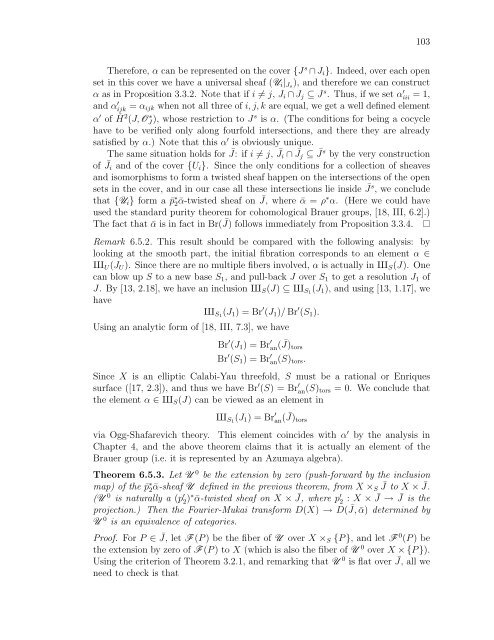derived categories of twisted sheaves on calabi-yau manifolds
derived categories of twisted sheaves on calabi-yau manifolds
derived categories of twisted sheaves on calabi-yau manifolds
You also want an ePaper? Increase the reach of your titles
YUMPU automatically turns print PDFs into web optimized ePapers that Google loves.
103<br />
Therefore, α can be represented <strong>on</strong> the cover {J s ∩ Ji}. Indeed, over each open<br />
set in this cover we have a universal sheaf (Ui|Js), and therefore we can c<strong>on</strong>struct<br />
α as in Propositi<strong>on</strong> 3.3.2. Note that if i = j, Ji ∩ Jj ⊆ J s . Thus, if we set α ′ iii = 1,<br />
and α ′ ijk = αijk when not all three <str<strong>on</strong>g>of</str<strong>on</strong>g> i, j, k are equal, we get a well defined element<br />
α ′ <str<strong>on</strong>g>of</str<strong>on</strong>g> ˇ H 2 (J, O ∗ J ), whose restricti<strong>on</strong> to J s is α. (The c<strong>on</strong>diti<strong>on</strong>s for being a cocycle<br />
have to be verified <strong>on</strong>ly al<strong>on</strong>g fourfold intersecti<strong>on</strong>s, and there they are already<br />
satisfied by α.) Note that this α ′ is obviously unique.<br />
The same situati<strong>on</strong> holds for ¯ J: if i = j, ¯ Ji ∩ ¯ Jj ⊆ ¯ J s by the very c<strong>on</strong>structi<strong>on</strong><br />
<str<strong>on</strong>g>of</str<strong>on</strong>g> ¯ Ji and <str<strong>on</strong>g>of</str<strong>on</strong>g> the cover {Ui}. Since the <strong>on</strong>ly c<strong>on</strong>diti<strong>on</strong>s for a collecti<strong>on</strong> <str<strong>on</strong>g>of</str<strong>on</strong>g> <str<strong>on</strong>g>sheaves</str<strong>on</strong>g><br />
and isomorphisms to form a <str<strong>on</strong>g>twisted</str<strong>on</strong>g> sheaf happen <strong>on</strong> the intersecti<strong>on</strong>s <str<strong>on</strong>g>of</str<strong>on</strong>g> the open<br />
sets in the cover, and in our case all these intersecti<strong>on</strong>s lie inside ¯ J s , we c<strong>on</strong>clude<br />
that {Ui} form a ¯p ∗ 2 ¯α-<str<strong>on</strong>g>twisted</str<strong>on</strong>g> sheaf <strong>on</strong> ¯ J, where ¯α = ρ ∗ α. (Here we could have<br />
used the standard purity theorem for cohomological Brauer groups, [18, III, 6.2].)<br />
The fact that ¯α is in fact in Br( ¯ J) follows immediately from Propositi<strong>on</strong> 3.3.4.<br />
Remark 6.5.2. This result should be compared with the following analysis: by<br />
looking at the smooth part, the initial fibrati<strong>on</strong> corresp<strong>on</strong>ds to an element α ∈<br />
XU(JU). Since there are no multiple fibers involved, α is actually in XS(J). One<br />
can blow up S to a new base S1, and pull-back J over S1 to get a resoluti<strong>on</strong> J1 <str<strong>on</strong>g>of</str<strong>on</strong>g><br />
J. By [13, 2.18], we have an inclusi<strong>on</strong> XS(J) ⊆ XS1(J1), and using [13, 1.17], we<br />
have<br />
XS1(J1) = Br ′ (J1)/ Br ′ (S1).<br />
Using an analytic form <str<strong>on</strong>g>of</str<strong>on</strong>g> [18, III, 7.3], we have<br />
Br ′ (J1) = Br ′<br />
an( ¯ J)tors<br />
Br ′ (S1) = Br ′<br />
an(S)tors.<br />
Since X is an elliptic Calabi-Yau threefold, S must be a rati<strong>on</strong>al or Enriques<br />
surface ([17, 2.3]), and thus we have Br ′ (S) = Br ′ an(S)tors = 0. We c<strong>on</strong>clude that<br />
the element α ∈ XS(J) can be viewed as an element in<br />
XS1(J1) = Br ′ an( ¯ J)tors<br />
via Ogg-Shafarevich theory. This element coincides with α ′ by the analysis in<br />
Chapter 4, and the above theorem claims that it is actually an element <str<strong>on</strong>g>of</str<strong>on</strong>g> the<br />
Brauer group (i.e. it is represented by an Azumaya algebra).<br />
Theorem 6.5.3. Let U 0 be the extensi<strong>on</strong> by zero (push-forward by the inclusi<strong>on</strong><br />
map) <str<strong>on</strong>g>of</str<strong>on</strong>g> the ¯p ∗ 2 ¯α-sheaf U defined in the previous theorem, from X ×S ¯ J to X × ¯ J.<br />
(U 0 is naturally a (p ′ 2) ∗ ¯α-<str<strong>on</strong>g>twisted</str<strong>on</strong>g> sheaf <strong>on</strong> X × ¯ J, where p ′ 2 : X × ¯ J → ¯ J is the<br />
projecti<strong>on</strong>.) Then the Fourier-Mukai transform D(X) → D( ¯ J, ¯α) determined by<br />
U 0 is an equivalence <str<strong>on</strong>g>of</str<strong>on</strong>g> <str<strong>on</strong>g>categories</str<strong>on</strong>g>.<br />
Pro<str<strong>on</strong>g>of</str<strong>on</strong>g>. For P ∈ ¯ J, let F (P ) be the fiber <str<strong>on</strong>g>of</str<strong>on</strong>g> U over X ×S {P }, and let F 0 (P ) be<br />
the extensi<strong>on</strong> by zero <str<strong>on</strong>g>of</str<strong>on</strong>g> F (P ) to X (which is also the fiber <str<strong>on</strong>g>of</str<strong>on</strong>g> U 0 over X × {P }).<br />
Using the criteri<strong>on</strong> <str<strong>on</strong>g>of</str<strong>on</strong>g> Theorem 3.2.1, and remarking that U 0 is flat over ¯ J, all we<br />
need to check is that
















